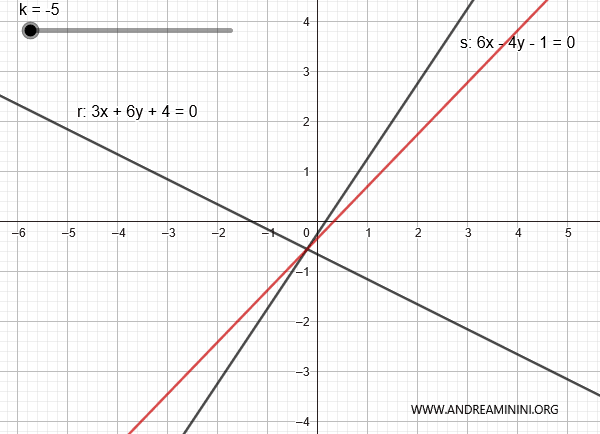Pencil of Lines
What is a Line Pencil?
A line pencil is a collection of lines in a plane defined by a specific selection criterion.
There are two types of line pencils: proper line pencil and pencil of parallel lines.
Pencil of Parallel Lines
A pencil of parallel lines consists of all lines parallel to a given line r in the plane.
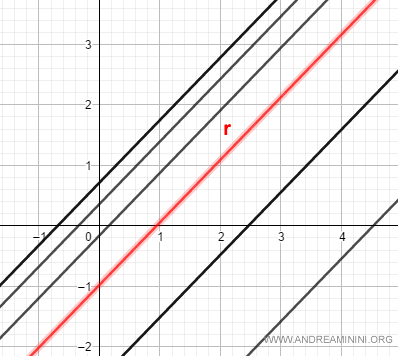
The Cartesian equation of an improper line pencil is:
$$ ax + by + c = 0 $$
where the coefficients a and b are non-zero.
Each line is identified by a specific value of c.
Note: The line r, which all other lines are parallel to, is also characterized by a specific value of c.
Alternatively, the equation of a parallel lines pencil can be written in explicit form as:
$$ y = mx + q $$
In this form, each line is characterized by a different value of the term q.
For q=0, the line passes through the origin.
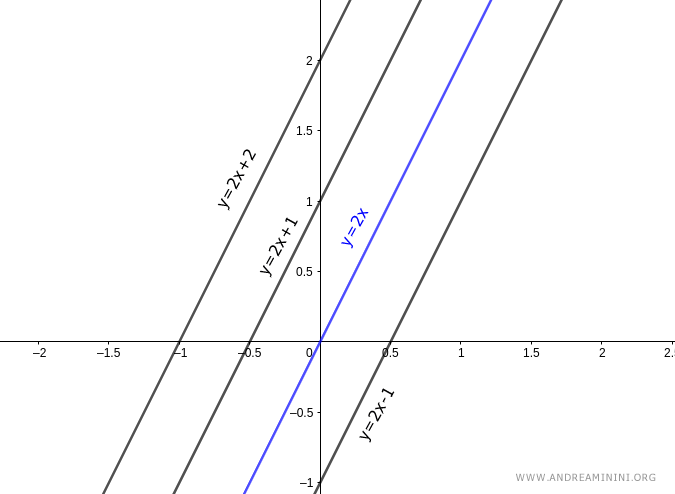
Note: The term q represents the y-intercept, which is the point where the line crosses the y-axis when x=0.
The parametric equation of the line pencil is:
$$ \begin{pmatrix} x \\ y \end{pmatrix} = \begin{pmatrix} x_0 \\ y_0 \end{pmatrix} + t \cdot \begin{pmatrix} l \\ m \end{pmatrix} $$
In this case, each line of the parallel lines pencil is defined by varying the combination (x0, y0).
The direction vector (l, m) remains the same for all parallel lines.
Example
The Cartesian equation of a line is:
$$ 2x + 3y - 12 = 0 $$
By changing the parameter c=12 to other values, we get an infinite number of parallel lines in the pencil.
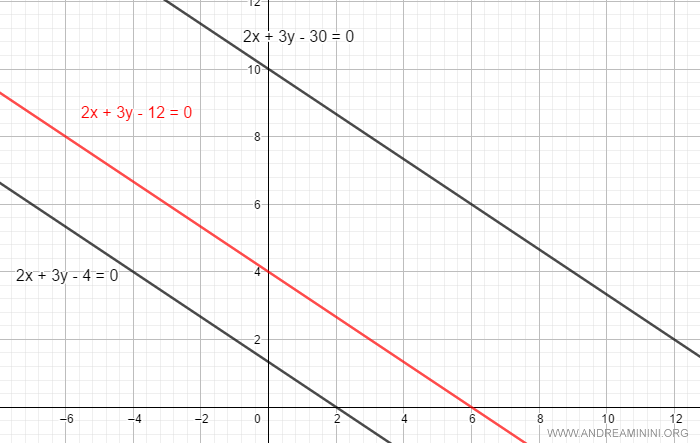
We can also write the line pencil as a parametric equation:
$$ \begin{pmatrix} x \\ y \end{pmatrix} = \begin{pmatrix} x_0 \\ y_0 \end{pmatrix} + t \cdot \begin{pmatrix} l \\ m \end{pmatrix} $$
$$ \begin{pmatrix} x \\ y \end{pmatrix} = \begin{pmatrix} 0 \\ 4 \end{pmatrix} + t \cdot \begin{pmatrix} 1 \\ -\frac{2}{3} \end{pmatrix} $$
By changing the parameter (0,4) of the intercept, we obtain all the other lines, keeping the direction vector unchanged.
The result remains consistent.
Line Pencil
A proper line pencil consists of all lines passing through a specific point (A) in the plane, known as the pencil center.
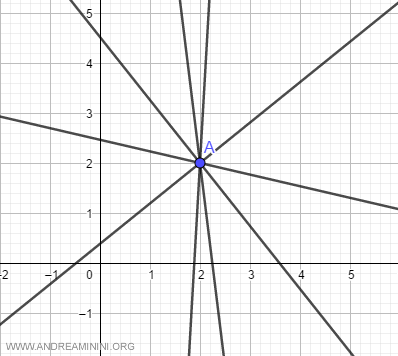
The equation of a proper line pencil centered at a point with coordinates (x0, y0) is:
$$ y - y_0 = m \cdot (x - x_0) $$
By varying the slope m ∈ R, we get all the lines in the proper pencil passing through point A, except for the line parallel to the y-axis.
Note: The line parallel to the y-axis cannot be expressed with the explicit equation y = mx because no value of m can provide this equation. For lines parallel to the y-axis, we use the equation x = x0. $$ x = x_0 $$
Therefore, the complete pencil of lines is described by the equations:
$$ \begin{cases} y - y_0 = m \cdot (x - x_0) \\ \\ x = x_0 \ \ \ \text{if the line is parallel to the y-axis} \end{cases} $$
< Example
Let's consider a pencil center C:
$$ C = \begin{pmatrix} x_0 = 2 \\ y_0 = 3 \end{pmatrix} $$
The equations for the pencil centered at C are:
$$ y - y_0 = m \cdot (x - x_0) $$
$$ x = x_0 $$
Given x0 = 2 and y0 = 3, the equations for the pencil become:
$$ y - 3 = m \cdot (x - 2) $$
$$ x = 2 $$
The first equation, y - 3 = m(x - 2), represents all lines with varying slopes m, except for the line parallel to the y-axis.
The second equation, x = 2, represents the line parallel to the y-axis (shown in red).
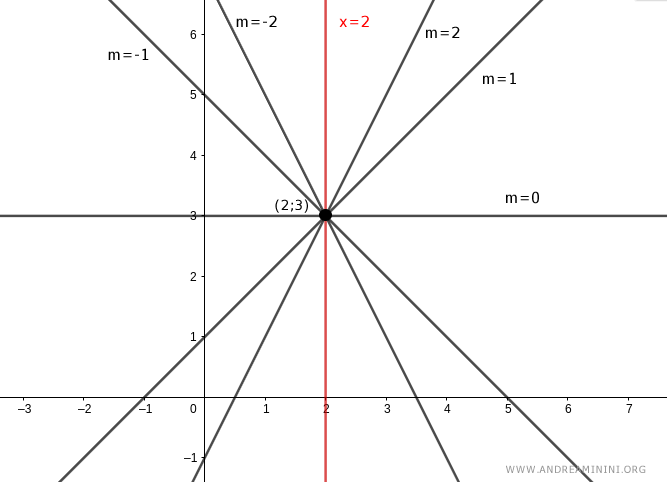
Line Pencil as a Linear Combination of Two Lines
A proper or improper line pencil can also be generated using a linear combination of two lines:
$$ r: ax + by + c = 0 $$
$$ s: a'x + b'y + c' = 0 $$
The linear combination of the two lines is:
$$ p \cdot (ax + by + c) + q \cdot (a'x + b'y + c') = 0 $$
Dividing both sides by p, we get:
$$ ax + by + c + \frac{q}{p} \cdot (a'x + b'y + c') = 0 $$
Letting $ k = \frac{q}{p} $, we have:
$$ ax + by + c + k \cdot (a'x + b'y + c') = 0 $$
$$ ax + by + c + a'xk + b'yk + c'k = 0 $$
Each value of $ k $ corresponds to a unique line in the pencil.
Note: This linear combination represents all lines in the pencil except for the line $ s: a'x + b'y + c' = 0 $, as no value of $ k $ corresponds to line $ s $. $$ ax + by + c + k \cdot (a'x + b'y + c') = 0 $$
Highlighting the common factors x and y:
$$ (ax + a'xk) + (by + b'yk) + c + c'k = 0 $$
$$ (a + a'k) \cdot x + (b + b'k) \cdot y + c + c'k = 0 $$
This is the general equation of the line pencil.
A line pencil can be either proper or improper:
- Proper Line Pencil
This occurs if the ratio of the coefficients a and b in the equations is different $$ \frac{a}{b} \ne \frac{ a'}{b'} $$ - Improper Line Pencil
This occurs if the ratio of the coefficients a and b in the equations is the same, as the two lines are either parallel or coincident. $$ \frac{a}{b} = \frac{a'}{b'} $$
Example
Consider the lines:
$$ r: 3x + 6y + 4 = 0 $$
$$ s: 6x - 4y - 1 = 0 $$
Here is the representation of the two lines in the plane:
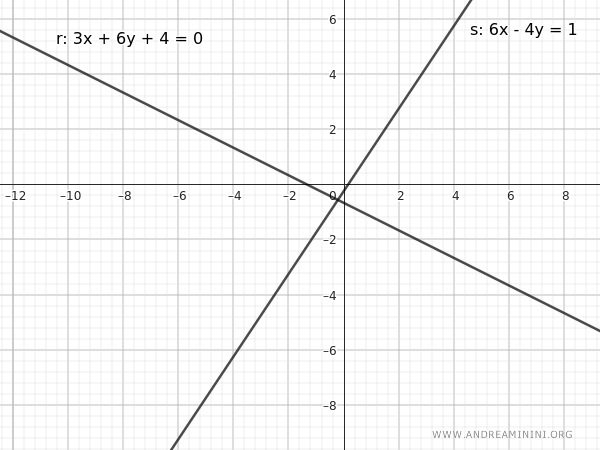
In this case, they intersect because the ratio of the coefficients is different:
$$ \frac{a}{b} \ne \frac{a'}{b'} $$
$$ \frac{3}{6} \ne \frac{6}{4} $$
Therefore, this is a proper line pencil.
The combination of the two lines is:
$$ 3x + 6y + 4 + k \cdot (6x - 4y - 1) = 0 $$
$$ 3x + 6y + 4 + 6xk - 4yk - k = 0 $$
$$ (3x + 6xk) + (6y - 4yk) + 4 - k = 0 $$
$$ (3 + 6k) \cdot x + (6 - 4k) \cdot y + 4 - k = 0 $$
By varying k, we can generate the other lines in the pencil, except for line s.
